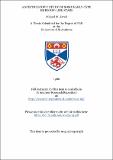Files in this item
A spectroscopic study of some early-type emission-line stars
Item metadata
| dc.contributor.advisor | Hilditch, R. W. | |
| dc.contributor.author | Jarad, Majeed M. | |
| dc.coverage.spatial | Spectroscopic observations of 18 of the brighter Be and 0e stars in the Northern Hemisphere have been presented in this project. About 900 spectrograms were secured and measured using the more objective numerical technique (REDUCE and VCROSS) to obtain as many accurate radial velocities as possible for these stars. The analysis of these measurements has demonstrated clearly, that most of these early-type stars are indeed variable in radial velocity, while a real periodicity in the radial velocities of some of the programme stars is found. The long-term periodicities were attributed to the binary nature, while the short ones could be ascribed to the pulsation phenomenon. Orbital elements are determined for four newly discovered binary systems, and improved orbits are determined for four known binaries. Five other stars display short time-scale periodicity (less than 1.5 days) attributable to radial or non-radial pulsation, whilst three variables show little evidence for periodicity. Only two stars are found to have constant radial velocities. A brief summary of the properties of Be stars and all the available models to explain the Be phenomenon is presented in chapter one. Chapter two contains a brief description of the observing equipment and the techniques used. The reasons for selecting the programme stars are given in the same chapter. A complete explanation of the measuring technique used in this investigation is given in chapter three. In chapter four, all the analyses and the results for each star are given individually, while a discussion of previous work on these stars appears in the relevant sections. The final chapter contains a discussion of the results from this study together with an analysis of the energy distributions of the programme stars, compiled by the author from published fluxes and photometry from the ultraviolet to the infra-red parts of the electromagnetic spectrum. Some consideration of future work to be done on these types of stars is also given. | en_US |
| dc.date.accessioned | 2018-06-21T14:54:53Z | |
| dc.date.available | 2018-06-21T14:54:53Z | |
| dc.date.issued | 1986 | |
| dc.identifier.uri | https://hdl.handle.net/10023/14418 | |
| dc.description.abstract | Spectroscopic observations of 18 of the brighter Be and 0e stars in the Northern Hemisphere have been presented in this project. About 900 spectrograms were secured and measured using the more objective numerical technique (REDUCE and VCROSS) to obtain as many accurate radial velocities as possible for these stars. The analysis of these measurements has demonstrated clearly, that most of these early-type stars are indeed variable in radial velocity, while a real periodicity in the radial velocities of some of the programme stars is found. The long-term periodicities were attributed to the binary nature, while the short ones could be ascribed to the pulsation phenomenon. Orbital elements are determined for four newly discovered binary systems, and improved orbits are determined for four known binaries. Five other stars display short time-scale periodicity (less than 1.5 days) attributable to radial or non-radial pulsation, whilst three variables show little evidence for periodicity. Only two stars are found to have constant radial velocities. A brief summary of the properties of Be stars and all the available models to explain the Be phenomenon is presented in chapter one. Chapter two contains a brief description of the observing equipment and the techniques used. The reasons for selecting the programme stars are given in the same chapter. A complete explanation of the measuring technique used in this investigation is given in chapter three. In chapter four, all the analyses and the results for each star are given individually, while a discussion of previous work on these stars appears in the relevant sections. The final chapter contains a discussion of the results from this study together with an analysis of the energy distributions of the programme stars, compiled by the author from published fluxes and photometry from the ultraviolet to the infra-red parts of the electromagnetic spectrum. Some consideration of future work to be done on these types of stars is also given. | en_US |
| dc.language.iso | en | en_US |
| dc.publisher | University of St Andrews | |
| dc.subject.lcc | QB883.J2 | |
| dc.subject.lcsh | Stars -- Spectra | en |
| dc.title | A spectroscopic study of some early-type emission-line stars | en_US |
| dc.type | Thesis | en_US |
| dc.contributor.sponsor | Iraq. Astronomy and Space Research Centre. | en_US |
| dc.type.qualificationlevel | Doctoral | en_US |
| dc.type.qualificationname | PhD Doctor of Philosophy | en_US |
| dc.publisher.institution | The University of St Andrews | en_US |
This item appears in the following Collection(s)
Items in the St Andrews Research Repository are protected by copyright, with all rights reserved, unless otherwise indicated.

